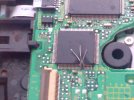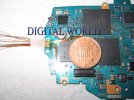- Joined
- Aug 2, 2007
- Messages
- 5,413
- Reaction score
- 7,025
Firstly you need magnification of some sort, i've used Kynar wire and even Magnet wire or enameled wire off old transformers....Who remembers the first Wii Chips, then we after that we had to dremel the chip to access the pins/connections !! less than a mm !!
You can see the groove in the chip were i filed it down and non of the legs touch, those were the days


